You can master empty space in jewelry design by using strategic openwork techniques that reduce material costs by 20-35% while enhancing visual appeal. Start with clean metal surfaces and use jeweler’s saws for precise piercing patterns. Balance negative space with metal elements to create anchor points that maintain structural integrity. Employ wire filigree methods for delicate openings, and apply strategic patinas to highlight contrasts. The interplay of light and shadow through deliberate voids creates depth and movement in your pieces, transforming simple designs into enchanting works that seem to dance with illumination.
Understanding Openwork Fundamentals in Modern Jewelry
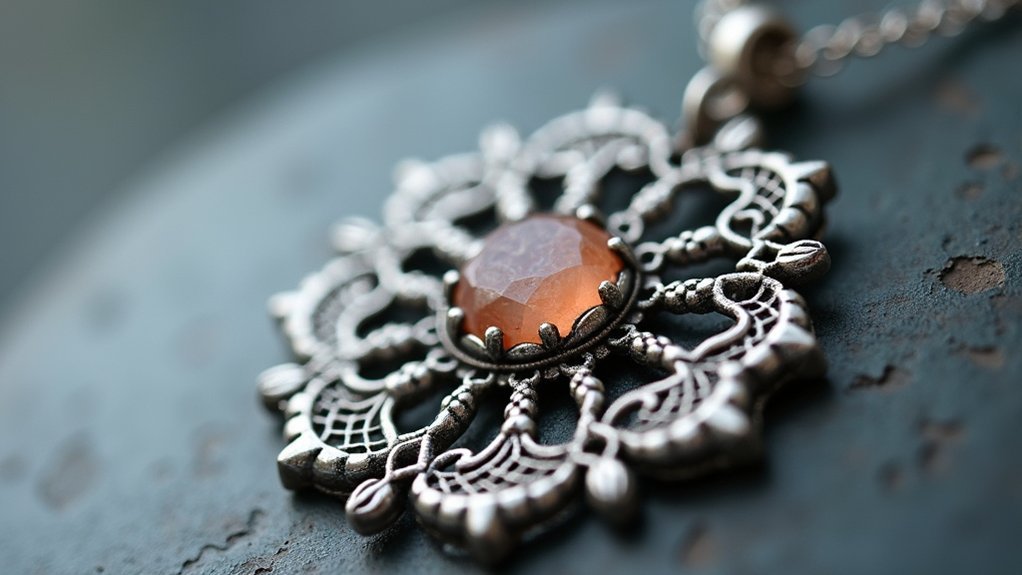
When you’re exploring modern jewelry design, openwork stands out as one of the most versatile techniques for creating visually striking pieces that balance sophistication with practicality.
This approach transforms negative space in jewelry into a powerful design element, where deliberate openings and voids become as important as the metal itself. You’ll find that openwork jewelry achieves remarkable visual impact while remaining lightweight and cost-effective.
The technique encompasses various methods including piercing, sawing, and strategic metal manipulation, allowing you to create everything from simple geometric patterns to intricate filigree work.
Balancing Negative Space With Metal Elements
You’ll achieve stunning jewelry designs when you master the art of distributing proportional space between open areas and metal components.
Your piece needs visual weight harmony, where neither the negative space nor metal elements dominate the overall composition.
Strategic metal placement becomes your key tool for creating anchor points that guide the eye while maintaining the delicate balance between presence and absence.
Proportional Space Distribution
Although metal forms the foundation of most jewelry pieces, the strategic use of negative space often determines whether a design appears heavy and overwhelming or elegant and refined.
You’ll need to master proportional space distribution to create compelling jewelry that captivates viewers while remaining comfortable to wear.
Learn how to create balance by carefully calculating the ratio between openwork and solid metal elements. An Open Heart pendant, for example, derives its visual interest from the interplay between the metal outline and the hollow center.
You can achieve this harmony through precise sawing and piercing techniques that maximize negative space impact without compromising structural integrity.
Consider how light travels through your open areas, creating dynamic shadows that enhance the piece’s overall aesthetic and memorability.
Visual Weight Harmony
Since visual weight determines how the eye perceives and moves across your jewelry piece, mastering the delicate balance between negative space and metal elements becomes essential for creating designs that feel both substantial and graceful.
You’ll want to distribute open areas strategically throughout your composition, ensuring they complement rather than compete with your metal components.
Consider how light and shadow interact within your openwork sections—this interplay creates dynamic visual experiences that enhance your piece’s overall appeal.
High-end designers leverage these techniques to achieve sophisticated lightness while maintaining intricate details, allowing for larger statements without excessive weight.
Focus on thoughtful negative space distribution to embrace minimalist philosophy, where simplicity doesn’t compromise impact but instead amplifies your design’s bold presence.
Strategic Metal Placement
Metal placement acts as the architectural framework that transforms your jewelry from mere decoration into wearable art.
You’ll create compelling visual narratives by strategically positioning metal elements around negative space, establishing dynamic contrasts that capture light and shadow beautifully.
Your openwork designs become more engaging when you balance solid metal components with carefully carved voids.
This approach draws viewers’ eyes to specific focal points while allowing their imagination to fill the spaces between.
Key strategies for effective metal placement:
- Use sawing and piercing techniques to create precise openings that enhance your design’s story
- Position metal elements to frame negative space and guide the viewer’s gaze
- Create structural integrity by maintaining supporting metal where stress points occur
- Minimize material usage while maximizing visual impact through thoughtful placement decisions
Piercing and Sawing Techniques for Creating Voids
Transform solid metal into enchanting jewelry by mastering the art of piercing and sawing to create deliberate voids in your designs.
You’ll use punches and drills for precise openings that emphasize negative space, creating intricate patterns that captivate viewers. The jeweler’s saw becomes your precision instrument, allowing controlled cuts for detailed openwork and complex shapes.
Start with basic geometric voids, then progress to elaborate filigree patterns. You’ll maintain structural integrity while achieving stunning visual effects through carefully planned negative spaces.
Sawing enables you to cut specific shapes and designs, enhancing visual interest through strategic material removal.
These techniques offer remarkable versatility—from simple cutouts to sophisticated lacework patterns.
You’ll notably reduce material usage, making your practice both cost-efficient and environmentally sustainable while creating jewelry that celebrates empty space as much as solid metal.
Using Light and Shadow to Enhance Visual Impact
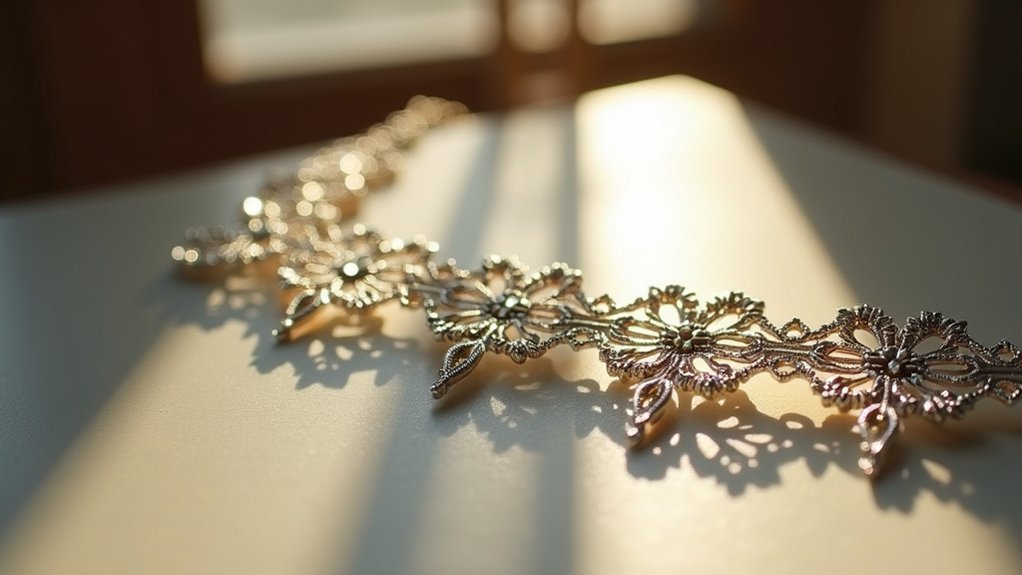
When you incorporate openwork into your jewelry designs, you’ll harness light’s transformative power to create pieces that shift and evolve with every movement.
The interplay between illuminated areas and shadows generates a dynamic visual experience that captivates viewers from multiple angles.
Strategic techniques to maximize light and shadow effects:
- Position openings strategically – Place voids where light can penetrate and create striking reflections that highlight your design’s intricate patterns and details.
- Create dramatic contrasts – Use negative space to generate shadows that add depth and dimension, making your piece more engaging and sophisticated.
- Design for movement – Plan openwork that changes appearance as light shifts, creating an ever-evolving visual experience.
- Balance weight and aesthetics – Openwork makes pieces appear lighter and more delicate while maintaining visual impact.
Material Cost Reduction Through Strategic Openings
You can markedly reduce material costs by strategically removing metal from your designs through openwork techniques.
This approach lets you create visually striking pieces that appear larger while using less precious metal, directly impacting your bottom line.
Smart planning of these openings won’t compromise your design’s integrity—it’ll enhance both aesthetics and affordability.
Strategic Metal Removal
Strategic metal removal revolutionizes jewelry design by incorporating deliberate openings that slash material costs while enhancing visual appeal.
You’ll discover that creating negative space through piercing and sawing techniques allows you to craft intricate patterns without compromising structural integrity.
This approach offers several key advantages:
- Cost efficiency – You’ll reduce material usage and lower production expenses
- Lightweight comfort – You can create larger pieces that won’t burden wearers
- Enhanced aesthetics – Light and shadow interplay creates dynamic visual interest
- Sustainable practice – You’ll minimize waste while maximizing creative potential
Cost-Effective Design Planning
Although precious metals command high market prices, smart design planning enables you to create stunning jewelry pieces while dramatically cutting material expenses. You’ll achieve significant cost reduction by incorporating openwork techniques that strategically remove metal while maintaining structural integrity and visual appeal.
| Design Element | Material Savings | Visual Impact |
|---|---|---|
| Geometric cutouts | 25-40% reduction | Enhanced light play |
| Filigree patterns | 30-50% reduction | Delicate sophistication |
| Negative space integration | 20-35% reduction | Modern aesthetic |
| Strategic perforations | 15-30% reduction | Textural interest |
You can create larger statement pieces without proportional cost increases by planning openings that maximize visual impact. This approach lets you explore innovative shapes and forms while keeping retail prices accessible. The interplay of light and shadow through carefully placed openwork enhances aesthetic value without compromising your budget constraints.
Material Savings Techniques
Building on these cost-reduction principles, specific material savings techniques transform your design approach from resource-intensive to strategically efficient.
You’ll discover that openwork designs strategically incorporate negative space, dramatically reducing material usage while maintaining visual impact.
Key Material Savings Techniques:
- Piercing and sawing methods – Create intricate patterns while minimizing metal requirements through strategic removal of material from existing pieces.
- Wire addition/subtraction techniques – Build complex designs using minimal wire components, adding or removing elements to achieve desired aesthetics.
- Lightweight construction strategies – Develop larger pieces without proportional weight increases by incorporating negative space throughout the design.
- Sustainable waste reduction – Minimize precious metal consumption while encouraging environmentally conscious practices that reduce production costs and retail prices.
Wire Filigree Methods for Delicate Empty Spaces
When you’re creating wire filigree, you’ll discover that the technique’s true artistry lies in the deliberate spaces left empty between twisted metal threads.
You’ll twist and weave fine gauge wire into intricate patterns, creating delicate voids that enhance your jewelry’s visual appeal through enchanting light and shadow play.
You’ll want to use sterling silver or gold for their malleability and professional finish.
Combine soldering and wrapping techniques to secure wire placement while preserving the airy aesthetic that defines quality filigree work.
Master the delicate balance between structural integrity and ethereal beauty by skillfully joining wire elements without compromising filigree’s signature openwork design.
Invest in essential tools: jeweler’s saw, pliers, and soldering torch for precise shapes and connections.
As you master these methods, you’ll create lightweight pieces that showcase exceptional craftsmanship.
The negative space you incorporate won’t just reduce material costs—it’ll add sophisticated elegance that distinguishes your designs.
Pattern Transfer and Finishing Techniques for Openwork Pieces
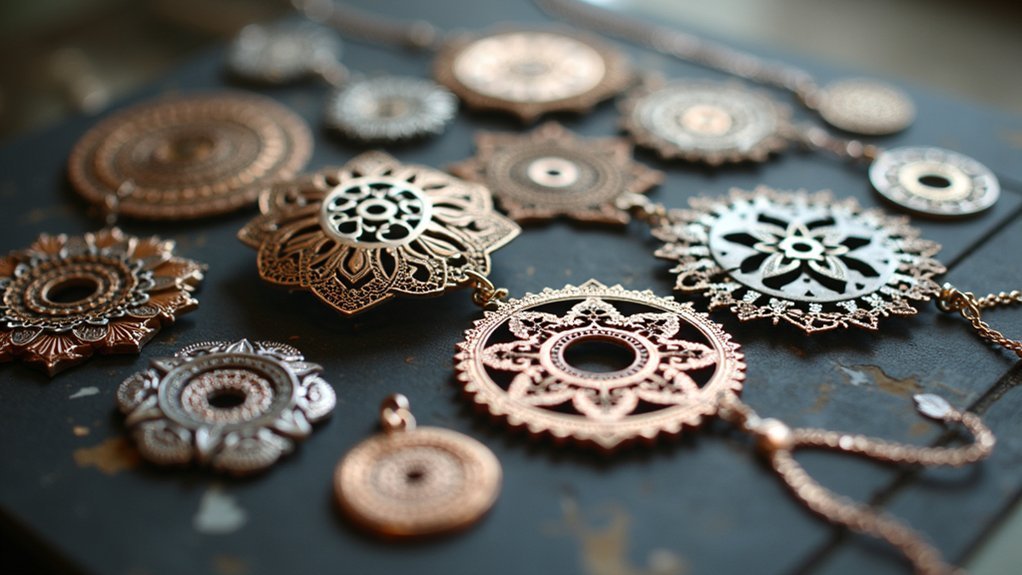
Three critical steps will transform your openwork jewelry from concept to polished masterpiece: precise pattern transfer, meticulous cutting, and expert finishing.
Start by guaranteeing your metal surface is completely clean and oxidation-free—this prevents adhesion problems that’ll compromise your design clarity.
Use a jeweler’s saw for precise cutting along transferred patterns, enabling intricate openwork that enhances visual appeal.
Essential Finishing Techniques for Openwork Success
- File and sand edges carefully to create smooth shifts between open and solid areas.
- Apply patinas strategically to highlight openwork features and create depth through contrast.
- Tumble finished pieces to achieve polished surfaces that reflect light beautifully.
- Accentuate negative space by using contrast techniques that emphasize the openwork design.
These methods guarantee your openwork pieces achieve professional-quality results.
Frequently Asked Questions
What Are the Basics of Jewelry Design?
You’ll master jewelry design by understanding proportions, balance, and material properties. Focus on combining aesthetics with functionality, experiment with metals and gemstones, and learn essential techniques like soldering and openwork to create wearable art.
Is Jewellery Designing Easy?
Jewelry designing isn’t easy—you’ll need to master complex techniques like soldering and sawing while balancing creativity with practical constraints. You’ll constantly learn new methods and adapt to evolving trends throughout your career.
How to Design a Jewellery Step by Step?
You’ll start by sketching your concept, then select materials like metals or gemstones. Next, you’ll create templates, cut or shape components, assemble pieces using soldering or wire techniques, and finally polish for finishing touches.
In Summary
You’ve learned how empty space can transform your jewelry from ordinary to extraordinary. Don’t underestimate negative space’s power to create drama and reduce material costs. Practice your piercing techniques regularly, and you’ll develop the precision needed for intricate openwork. Remember that light and shadow work together to bring your designs alive. Start with simple patterns, then gradually tackle more complex filigree work as your confidence grows.

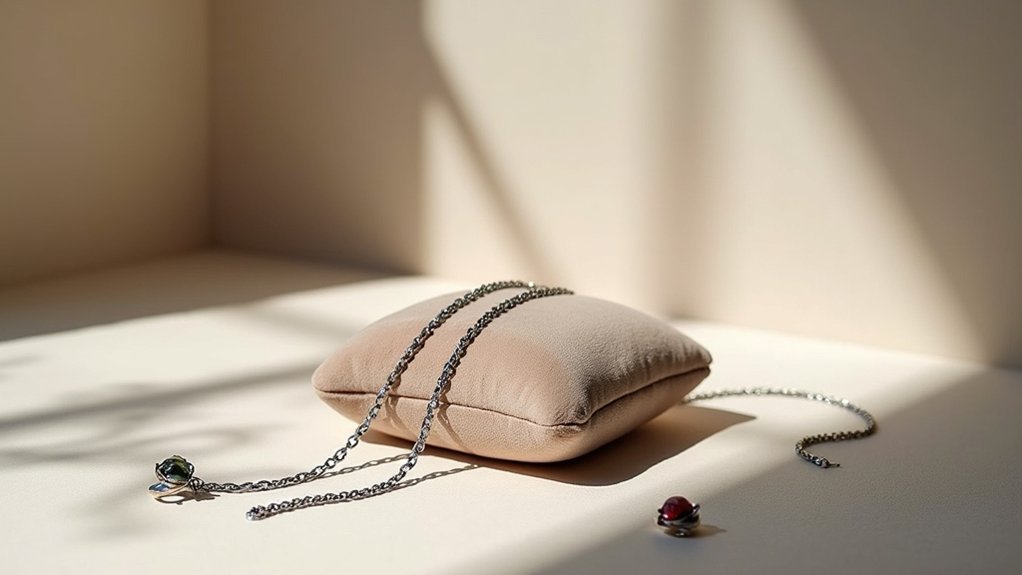
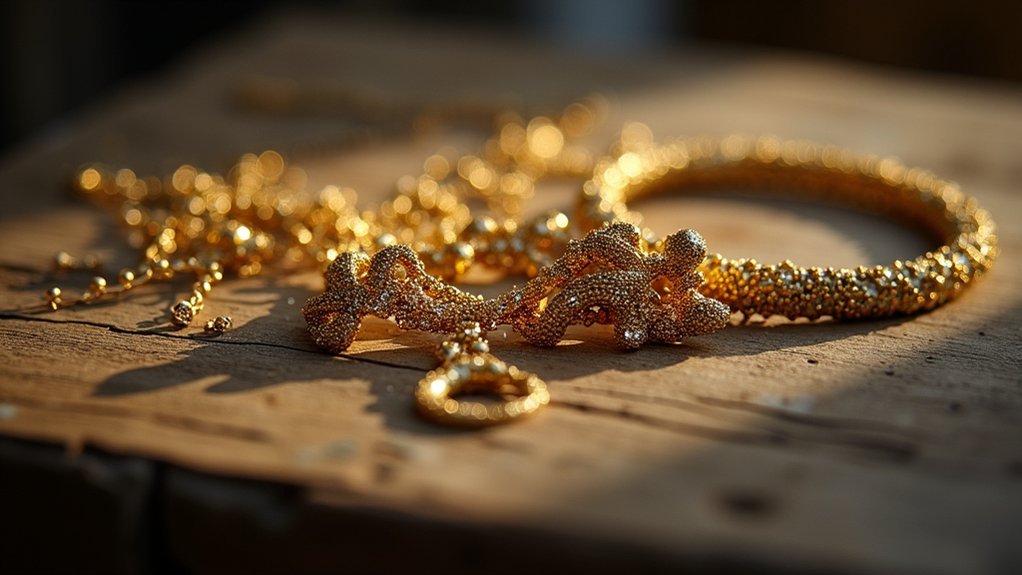
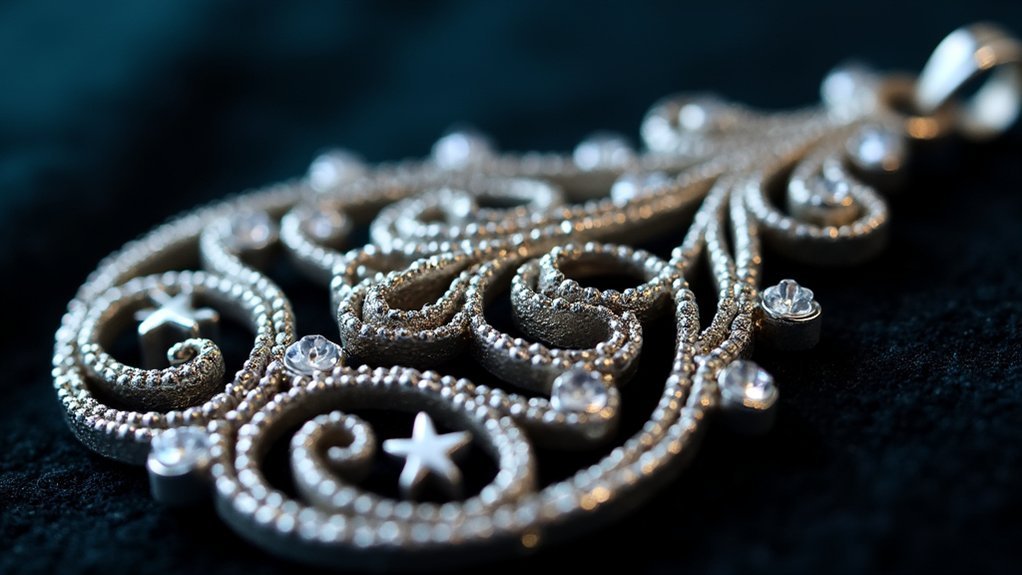
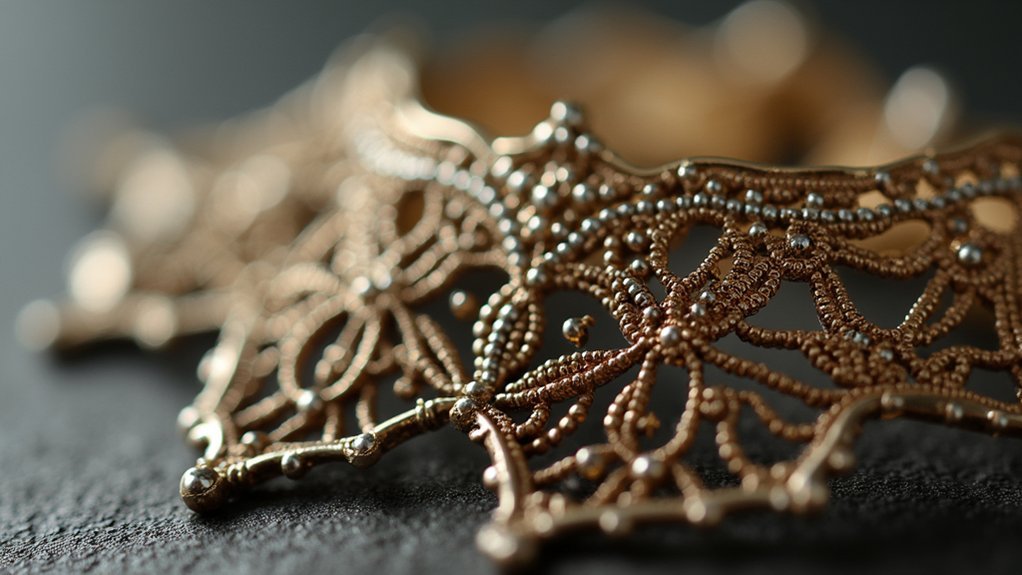
Leave a Reply